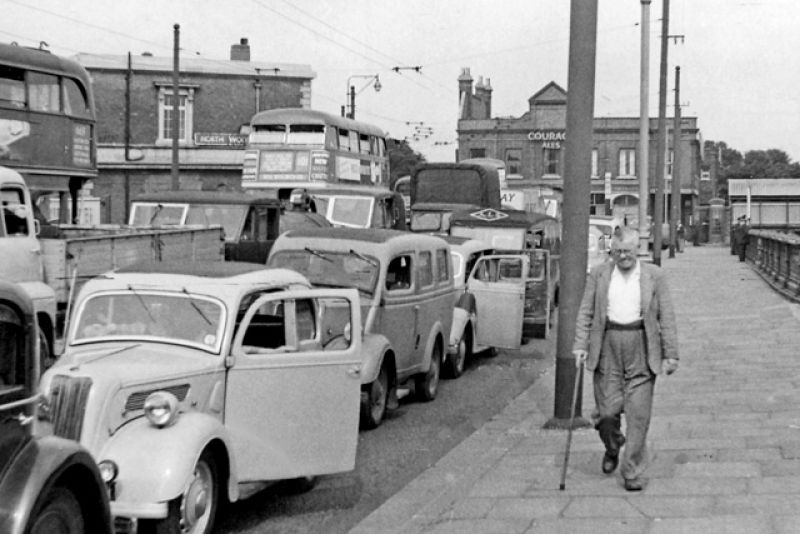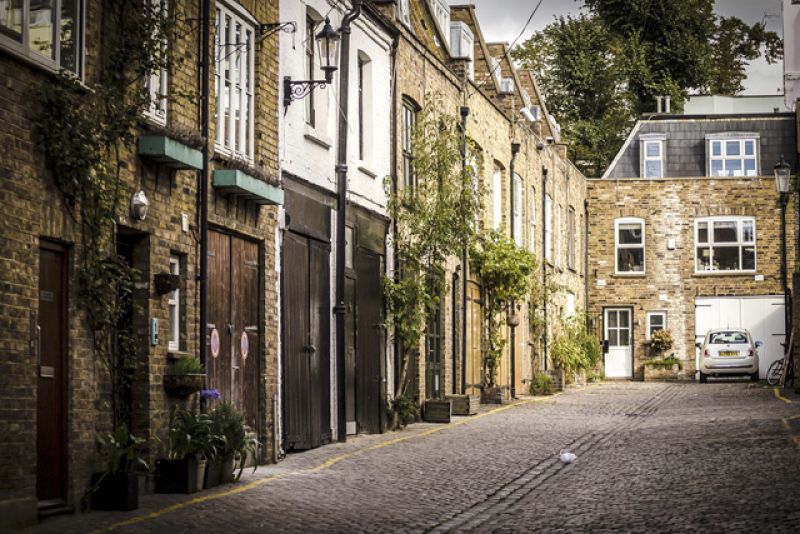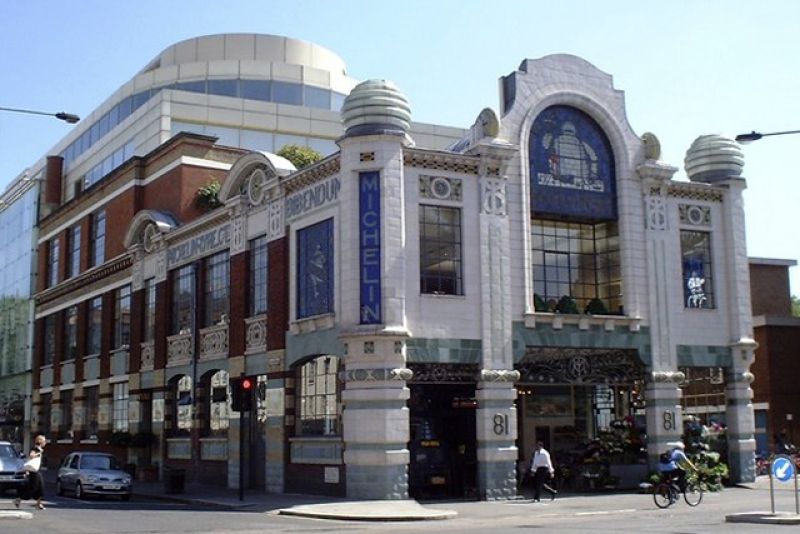Created Date:
Last Modified:
Metamet
An early stockist of post-Second World War military vehicles, best known for their U.S military Jeep conversions.
Location
100, Belsize Lane, NW3, and 20, Daleham Mews, London, NW3.
Date
1947 – early 1970s.
-
 Metamet employees with one of their Jeeps outside the workshop on Belsize Lane. Filip Rosz is sitting in the right-hand front seat, © Anita Long
Metamet employees with one of their Jeeps outside the workshop on Belsize Lane. Filip Rosz is sitting in the right-hand front seat, © Anita Long -
 © Anita Long.
© Anita Long. -
 The American Bantam Jeep prototype, 1940. It is believed that its designer, Karl Probst, is the figure in shirtsleeves at the rear of the car, leaning on the spare wheel, © The Smithsonian Institute, the National Museum of American History https://american history.si.edu/collections/
The American Bantam Jeep prototype, 1940. It is believed that its designer, Karl Probst, is the figure in shirtsleeves at the rear of the car, leaning on the spare wheel, © The Smithsonian Institute, the National Museum of American History https://american history.si.edu/collections/ -
 Two of the thousands of Jeep in the British and Commonwealth Armed Forces, Caen, Normandy, 1st August 1944, source: Imperial War Museum, via https://picryl.com
Two of the thousands of Jeep in the British and Commonwealth Armed Forces, Caen, Normandy, 1st August 1944, source: Imperial War Museum, via https://picryl.com -
 The Metamet Jeep hood could be raised and lowered with one hand and gave greater protection than the standard version fitted to the original Jeep, source: Tony Thorpe collection
The Metamet Jeep hood could be raised and lowered with one hand and gave greater protection than the standard version fitted to the original Jeep, source: Tony Thorpe collection -
 The Station Wagon, described in the company’s brochure as ‘the pride of our fleet’ and the only passenger car on the market with four-wheel drive giving ‘sufficient room and comfort’, source: Tony Thorpe collection
The Station Wagon, described in the company’s brochure as ‘the pride of our fleet’ and the only passenger car on the market with four-wheel drive giving ‘sufficient room and comfort’, source: Tony Thorpe collection -
 Outside the workshop on Belsize Lane; the man resting his foot on the front bumper is believed to be Sergei Chrulew, © Anita Long
Outside the workshop on Belsize Lane; the man resting his foot on the front bumper is believed to be Sergei Chrulew, © Anita Long -
 From the programme of the 1948 Film Garden Party, held at Morden Hall on 10th July 1948, © Anita Long
From the programme of the 1948 Film Garden Party, held at Morden Hall on 10th July 1948, © Anita Long -
 Metamet Jeeps were used to transport celebreties to the Garden Party, Filip Rosz is pictured in the passenger seat, © Anita Long
Metamet Jeeps were used to transport celebreties to the Garden Party, Filip Rosz is pictured in the passenger seat, © Anita Long -
 A two-door convertible Metamet, looking very much like the Metaplan advertised in the Metamet brochure. This example was originally owned by Wlodik Wisniewski, a partner in the Metamet company, © Dave Eilers
A two-door convertible Metamet, looking very much like the Metaplan advertised in the Metamet brochure. This example was originally owned by Wlodik Wisniewski, a partner in the Metamet company, © Dave Eilers
Commentary
Early in 1940, with Europe and Asia becoming embroiled in war, the U.S War Department (possibly recognising the likelihood of its own involvement) identified the need for a light reconnaissance vehicle, able to move men, armaments and supplies quickly and flexibly on the field of battle.
In order to start this process, the Department put out a request, in early July 1940, asking U.S car makers to submit design proposals for just such a vehicle, following a stringent specification. The deadlines for this were extremely tight. Applicants were given just eleven days to prepare their bids; 49 days to submit a prototype; and 75 days to complete a further number of test vehicles.
Just two companies submitted a bid: the American Bantam Car Company, and Willys-Overland. The contract was initially awarded to American Bantam, who were alone in being willing to meet the Department’s deadlines. (American Bantam had begun in 1930 as the American Austin Car Company, set up to build re-bodied versions of the British Austin Seven.)
The Bantam prototype was delivered to the Army test centre on 23rd September 1940, and seems to have met most of the War Department’s criteria, except those relating to weight and engine torque.
There were also concerns that American Bantam would not have the capacity to produce the new vehicle in sufficient numbers within a relatively short space of time and, in view of this, the War Department decided to invite Willys-Overland and Ford to bid for the manufacturing rights of the Bantam design. In doing so, the two larger companies suggested various modifications, such as a more powerful engine (from Willys) and small, but significant, changes to the design including a flat bonnet and wings (from Ford).
The first production rights to this hybrid design were awarded to Willys, with Ford later receiving a contract in order to step-up production levels. Although American Bantam did manufacture a number of the early vehicles, their main responsibility, in this respect, was the production of the Jeep’s two-wheeled trailer.
It is believed that the British Army’s first Jeeps came into service in mid-1941. When they arrived in Northern Ireland in March 1942, the Ballymena Weekly Telegraph explained to its readers the vehicle’s most salient features:
“11 ft. long, 56 in. wide and 40 in. high, it has a 60 h.p engine, with six speeds forward and two reverse. It can claw up or descend steep banks, be kept going through water, carry a machine-gunner or tow an anti-tank gun. It can be a radio patrol-car, lay a smokescreen, or be used for reconnaissance.”
The article continued: “Its performance is so remarkable that General George Marshall, Chief of the US Army Staff, describes it as America’s main contribution to modern war”.
More than 630,000 Jeeps were built by Willys and Ford during World War Two. The British Army Jeep Research Group estimates that as many as 100,000 may have been supplied to British and Commonwealth forces.
Although the conflict in Europe and Japan had largely come to an end by September 1945, detailed decisions on how to dispose of the mountain of British and U.S wartime stock took some time to be made. All items needed to be checked, counted and valued; and then agreement reached with the American authorities over exactly how they would be disposed of.
It wasn’t until August of the following year that the general sale of ex-military vehicles finally got underway. The numbers involved were huge; in one sale, at Bourton-on-the-Water in Gloucestershire, 10,000 vehicles, including 4,000 Jeeps, were sold over an eight-week period between mid-October and mid-December 1946.
With a typical sales price of around £100, and an acute shortage of new and serviceable second-hand vehicles in Britain, the demand for the ex-Army Jeeps was sky-high.
One unforeseen consequence of this was, in late 1946 and early 1947, a sharp rise in a certain category of motoring offence in England; that of “causing a trailer to be drawn in excess of the number authorised”.
The trailers, in this case were not the usual flatbed, or box-type, but ex-US Army Jeeps, with two, or even three, being towed behind another Jeep or ex-Army truck.
One of those who faced charges of towing a trailer in excess of the number authorised was Felix Zakrezewski, who was stopped on 20th February 1947 by PC Baker as he towed a train of two Jeeps behind a third through Saffron Walden, in Essex. He was making his way back to C.J Stewart & Co., motor engineers, of Belsize Lane, where he worked as a mechanic.
C.J. Stewart & Co., or Metamet, as it was soon to become, was one of the earliest and most successful companies stocking and converting ex-military vehicles for peacetime use.
In early 1947, they sold their first Jeep conversion, known as the ‘Five in One’ model. As the company brochure explained: with a hinged convertible hood, the vehicle could be transformed into “an open tourer, an enclosed drop head coupé, a weatherproof sports cabriolet, or to any of the five intermediate types, in a matter of seconds”.
The Metamet Jeep also came with a bench-type front seat, detachable steel-framed side screens and full-sized steel doors.
Other variations on the Jeep theme soon followed. In addition to the ‘Standard Model’, which seems to have largely been a re-conditioned original vehicle, there was a ‘Saloon’, ‘Farmer Model’, and ‘Shooting Brake’, all on the standard 80-inch wheelbase. Also offered was the ‘Station Wagon’, the ‘Caravaner’, the ‘Metaplan’ (a two-door convertible), two trucks, and a 15-cwt van, each with an extended 100-inch wheelbase.
The passenger and luggage sections of the Shooting Brake and Station Wagon were built of seasoned wood, and were not dissimilar in general appearance to other British ‘woodies’ of the late-40s and early-50s.
Also facing the magistrates, with Felix Zakrezewski at Saffron Walden Borough Petty Sessions, was his employer, Sergei Chrulew, C.J Stewart’s company secretary. The two men were charged with seven offences in all, and were required to pay fines and costs totalling almost £20. Felix Zakrezewski was also disqualified from driving for 12 months.
Sergei Chrulew’s involvement in the business may be explained through a possible family connection with the Stewarts. In April 1940, a Sergei Chrulew and Constance J Stewart were married in Hampstead and, three years later, announced the birth of their son, Stephen.
By 1948, the company’s name had been changed to Metamet Accessories Ltd, and new premises opened at nearby at 20 Daleham Mews. Sergei Chrulew remained as managing director
First-hand accounts from customers describe Metamet as an Aladdin’s Cave – a goldmine for parts with Jeep (plus Dodge, Ford and Chevrolet) spares stacked everywhere.
In addition to re-building and modifying Jeeps, Metamet also provided vehicles for the Sunday Pictorial Film Garden Parties. These took place between 1947 and 1951 at Morden Hall Park in south London, owned by the National Trust. Organised in aid of the NSPCC and Children’s Society, and with British and American film stars as special guests, they drew huge crowds, giving a chance for many people to meet their screen heroes.
The other interesting feature of Metamet was that many of the staff (including Felix Zakrezewski and Sergei Chrulew) were originally from Poland. Some were former soldiers, who had often endured huge privation before ultimately reaching safety in Britain.
One such person was Filip Rosz, born in the city of Lwów, then in Poland. Taken prisoner by the Soviets in 1939 and deported to a prisoner of war camp in Siberia, he was released in 1941, following the agreement reached between the Soviet and Allied authorities. After joining the Polish II Corps, he travelled south to Iran and Egypt and then, in 1944, to Monte Cassino in Italy where he served as a mechanic and driver. At the end of the War, Filip was shipped to a settlement camp at Strood Park in Sussex. On the day of his discharge, in September 1948, he joined Metamet at Daleham Mews.
It is not clear to this writer when Metamet finally closed its doors. Anecdotal evidence suggests that this was in the early 1970s. Sergei Chrulew died in London in 1998, at the age of 92.
With thanks to Anita Long, Neil Hubbard and David Eilers for their help in the preparation of this article.
Further details
• “A Brief History of Jeep”, Autoweek, July 2016, www.autoweek.com.
• “Historic Metamet Jeeps Archive Discovered”, Neil Huband, Key Military, January 2023, www.keymilitary.com.
• “40 Years of Sleep”, Robert U’ren, Key Military, January 2023, www.keymilitary.com.
• “Metamet, Jeep History Discovered”, Imprint (The quarterly magazine of the Invicta Military-Vehicle Preservation Society), Volume 42, Issue 22, Summer 2022.
• British Army Jeep Research: www.britishjeep.com.













